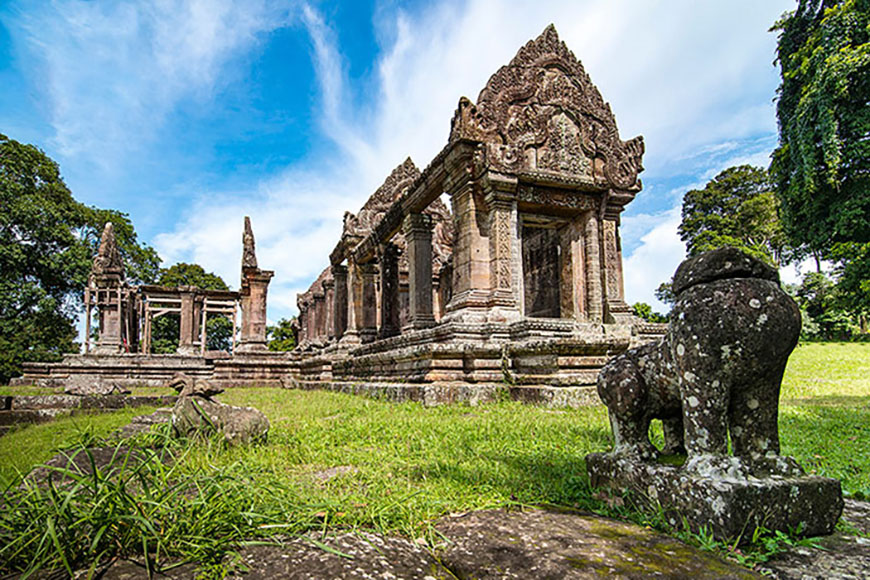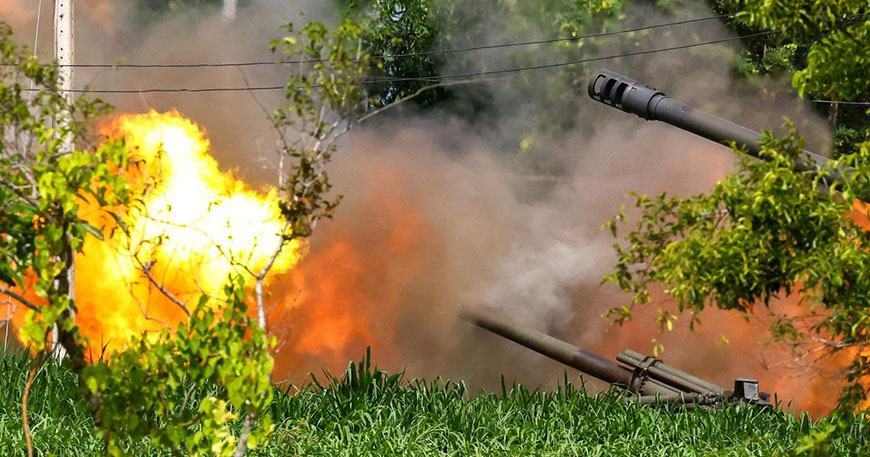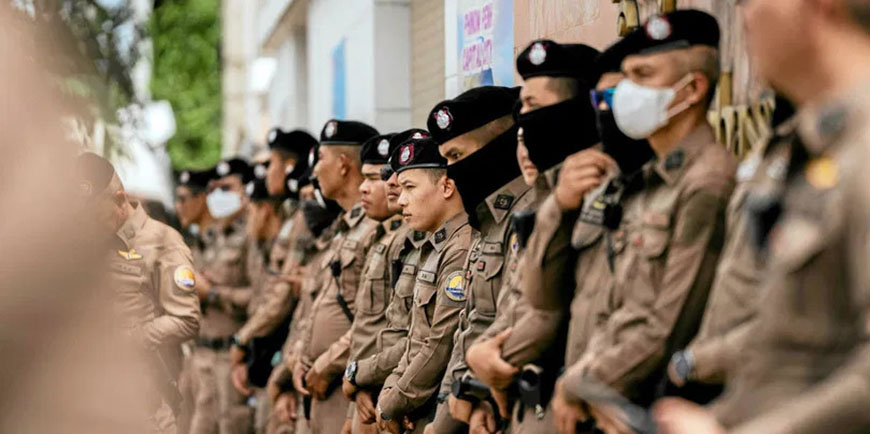The French protectorate over Cambodia led to a strict demarcation by a mixed Franco-Siamese commission in 1907-1908, which placed the Preah Vihear temple under Cambodian control. This 817 km long border is considered arbitrarily drawn by Siam. Siam always disputed the French-made maps, claiming they didn't have full access to the surveys and questioned their clarity and accuracy.
The core of the current claims comes from this 1907 map, which Cambodia uses as a reference, while Thailand challenges its accuracy and acceptan.
Tensions surrounding the Preah Vihear temple
Built in the 11th century by the Khmer Empire, the
Preah Vihear temple is located on a cliff in the Dângrê mountains. This site, part of the Cambodian people's historical and cultural heritage, has become a focal point for military clashes, political fallout, and international legal battles.
Considered a "secular symbol of national pride" for both nations, the ICJ awarded the temple and its promontory to Cambodia in 1962. While this decision is still legally accepted, the adjacent border area remains disputed because the ICJ did not rule on its precise fate. The site's inscription as a
UNESCO World Heritage site in 2008, at Cambodia's request, reignited the dispute. Thailand viewed this international recognition as an encroachment on its land, fueling a wave of nationalism on both sides and leading to deadly clashes between 2008 and 2011, and again since February 2025.
The ICJ's 1962 interpretation, based on Thailand's "implicit acceptance" of the 1907 French map, highlights a fundamental difference between international legality and national historical perception. The Court noted that Thailand had "not objected to the map at the time, nor at any other time, until Cambodia's independence from France". For Thailand, this historical omission legally binds it to a border it considers inaccurate, fueling deep resentment and a sense of injustice, especially concerning the surrounding land not explicitly covered by the 1962 decision. This persistent bitterness explains why legal decisions haven't brought lasting peace and why the dispute remains so sensitive.
Current state of the conflict
The current wave of tensions erupted in
May 2025 following a skirmish in the
Emerald Triangle, a border region shared with Laos, resulting in the death of a Cambodian soldier. Both nations immediately accused each other of initiating the aggression. This initial confrontation quickly escalated, causing a
diplomatic breakdown and significantly impacting Thai domestic politics. Since
July 2025, the conflict has spread to several border sectors, leading to
artillery exchanges, air strikes, over 30 deaths, and hundreds of thousands displaced. Despite calls for a ceasefire and international mediation attempts, particularly by the United States and ASEAN,
negotiations remain fragile and interrupted by regular resumptions of hostilities. Cambodia has specifically called on the ICJ to rule on other areas (Mom Bei, Ta Moan Thom, Ta Moan Tauch, Ta Krabei), while Thailand conditions peace on Cambodia's "good faith" and an end to border crossings.
 The Preah Vihear Temple, a place of pilgrimage and worship for Cambodian
The Preah Vihear Temple, a place of pilgrimage and worship for Cambodian Diplomatic consequences and economic retaliation
The conflict quickly led to a
deterioration of diplomatic relations. Thailand recalled its ambassador and threatened to expel Cambodia's envoy. Cambodia retaliated by lowering its diplomatic ties to the lowest level and recalling all embassy staff from Bangkok. Economic measures were quickly implemented. Thailand closed its entire border with Cambodia. Cambodia banned imports of Thai fruits and soap and stopped importing fuel from Thailand. Threats to essential services were also made. Thailand threatened to cut electricity and internet links to Cambodian border towns. Cambodia, in turn, boycotted some international internet connections and electricity supply from Thailand.
Strategic stakes and prospects
This conflict is not just a territorial dispute; it encompasses several major issues:
- ♦ National Sovereignty and Identity: Control of Preah Vihear and other sanctuaries enhances the national prestige of both countries and serves as a political lever domestically.
- ♦ Economic Issues: Border control also means control over major roads, natural resources, and trade in a key region for regional integration.
- ♦ Regional Stability for ASEAN: Military confrontation between two members compromises the organization's credibility as a forum for security dialogue.
 The border conflict between Cambodia and Thailand - Photo : Athit Perawongmetha @REUTERS
The border conflict between Cambodia and Thailand - Photo : Athit Perawongmetha @REUTERSRole of Chinese influence
China plays
a major but seemingly neutral role. It has become
Cambodia's main ally, donor, and strategic partner (massive investments, military cooperation), while Thailand tries to maintain a more independent diplomacy. Beijing officially calls for de-escalation but positions itself as an interested mediator, taking advantage of regional fragility to strengthen its influence in Southeast Asia, put pressure on ASEAN, and counter American influence in the area. This
growing dependence of Cambodia on China is a source of additional tensions, with Bangkok perceiving Chinese support for Phnom Penh as a destabilizing factor. However, China is in a unique position as the top trading partner and major investor for both Thailand and Cambodia, giving it significant economic leverage. Its military ties are "particularly close" with Cambodia, including access to the strategically important Ream naval base near the South China Sea. This dual relationship requires China to maintain a "delicate balance". Although it publicly advocates for peace and de-escalation among its neighbors, its deeper strategic interests in Cambodia (e.g., naval access, regional influence) and broader geopolitical goals mean it cannot be truly neutral.
Broader US-China competition in Southeast Asia
The conflict is part of the broader competition between the United States and China for influence in the rapidly growing Southeast Asian region. It is explicitly presented as part of a "larger geopolitical struggle in Asia-Pacific". T
he United States has a long-standing security partnership with Thailand, characterized by military cooperation and extensive exercises. Conversely,
China's increasing economic and political support for Cambodia strengthens Phnom Penh's allegiance to Beijing. This rivalry increases the risk that local conflicts could be drawn into a larger power struggle, complicating de-escalation efforts. Disputes in the South China Sea, where China has extensive claims, are primarily driven by "national myth-making and political legitimacy" and "historical rights" rather than purely military or commercial logic in China's case. However, the region is recognized for its potential oil and gas reserves and its critical role as a global shipping lane.
 Cambodia-Thailand border conflict is a complex and deeply rooted issue
Cambodia-Thailand border conflict is a complex and deeply rooted issueRole and limits of ASEAN
The
Cambodia-Thailand border conflict highlights ASEAN's structural limitations in managing tensions between its members. Despite its aim to promote regional peace, the organization is hampered by two fundamental principles: non-interference and decision-making by consensus. Malaysia, the current ASEAN chair, has tried to mediate by proposing a ceasefire and facilitating dialogue. However, these efforts face resistance from the parties, especially Thailand, which prefers bilateral negotiations.
This conflict represents a crucial test for ASEAN. Its inability to intervene effectively calls into question its credibility and relevance as a regional organization. Experts suggest creating an ad hoc mediation commission to overcome these institutional blockages. The situation reveals an intrinsic tension: commitment to regional stability versus the principle of non-interference. This contradiction might require an adaptation of ASEAN's traditional model. Internationally, the UN, the United States, and human rights organizations have called for de-escalation, emphasizing humanitarian issues and the need to protect civilian populations. This conflict could therefore become a decisive moment, potentially catalyzing a structural reform of ASEAN to enable it to better manage regional crises.
Conclusion
The Cambodia-Thailand border conflict is
a complex and deeply rooted issue, shaped by a mix of colonial legacy, differing legal interpretations, strong nationalist sentiments, domestic political dynamics, and broader geopolitical interests. The 2025 escalation highlighted the
cyclical nature of the dispute, the
devastating impact on civilians, and the
limitations of regional conflict resolution mechanisms.
A lasting resolution requires a comprehensive and sustained approach that goes beyond simply managing symptoms. The multifaceted nature of the conflict clearly indicates that a single approach (e.g., only bilateral talks or exclusive reliance on ICJ decisions) is insufficient for lasting resolution. The current situation already involves a mix of bilateral discussions, ASEAN mediation efforts, and calls from various international actors. Effective resolution therefore requires a comprehensive "multi-channel diplomacy" approach, a holistic strategy needed to address the diverse and interconnected dimensions of the conflict.
TRAVEL RECOMMENDATIONS: THAILAND-CAMBODIA
Immediate actions
Cancellation of travel
• Suspend all travel to border areas
• Avoid land crossings between Thailand and Cambodia
Precautionary measures
• Regularly consult the official diplomatic councils
• Take out comprehensive travel insurance
• Specifically covering potentially unstable areas
Strategies for future travel
Choice of destinations
• Prioritize secure areas
• Maintain Siem Reap and Angkor Wat as possible destinations
• Targeting the South of Thailand
Preparation and vigilance
• Follow geopolitical news in real time
• Develop fallback routes
• Stay flexible in planning
Key advice: Caution and adaptability are essential.